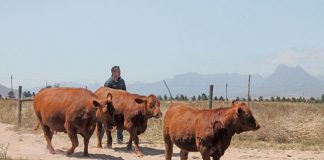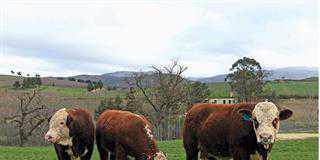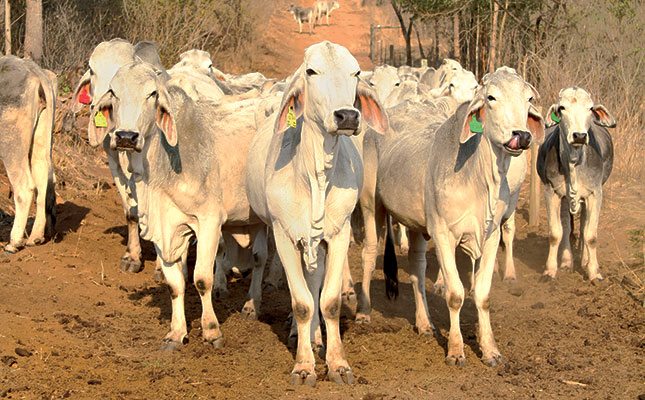Temperature fluctuations (more than 15°C between day and night temperatures), dust, stress, nutritional deficiencies and immune-compromising diseases such as bovine viral diarrhoea, enzootic bovine leucosis and enzootic abortion all play a role in outbreaks of pneumonia in animals. There are numerous vaccines available to immunize animals against respiratory diseases.
Other diseases that were reported in numbers were the tick- and insect- transmitted diseases African and Asiatic redwater, anaplasmosis, lumpy skin disease and bluetongue. The venereal disease trichomonosis is causing serious reproduction losses and bovine brucellosis needs all of our attention.
Contact your vet to help you update your vaccination and management programmes for your production animals.
Internal parasites
- Roundworms: Wireworm infestation was the biggest problem. Farmers should continuously assess the efficacy of the anthelmintic group used and record it. Beware of resistance.
- Tapeworms: Reports of infestations in lambs and calves were received from Mpumalanga, Gauteng, North West, Free State and Western Cape.
- Parafilaria: cattle with bleeding spots were reported in KZN. At slaughter these lesions will be removed and farmers will lose revenue. Animals should be treated 70 days before slaughter to allow the lesions to heal. Discuss treatment with your vet.
- Flukes: Study reports from abattoirs to see whether slaughtered animals were infested with liver fluke and discuss control measures with your vet.
Reports of conical fluke were received from Mpumalanga, Free State, KZN, Eastern Cape and Western Cape. Be on the lookout for animals with profuse diarrhoea after being moved to camps where there are wet vleis or dams where the infected water snails are present.
* Cysticercosis (measles): Measles are constant findings in slaughter stock and farmers should strive to prevent infection of animals. Source the origin of the infestation and install preventative measures.
* Coccidiosis: Infections were reported from Mpumalanga, Gauteng, Free State, KZN, Eastern Cape and Western Cape. Young animals are especially affected and the clinical sign is diarrhoea. Wet and muddy conditions are an ideal place for young animals to become infected with this parasite. Discuss preventative measures with your vet.
External parasites
* Ticks: Extremely high blue tick-burdens were seen in many areas due to the hot weather experienced during the month.
With the increase in game farming, hosts such as warthogs and kudu are carrying the bont or heartwater tick to new areas.
The Bont legged-tick was reported in Mpumalanga, Limpopo, North West, Free State, Eastern Cape, Western Cape and Northern Cape. The toxin of this tick causes sweating sickness and some ticks may transit the Congo fever virus to humans. When these ticks attach between the hooves of animals they may cause lameness. The very long mouthparts cause wounds which are infested by screw-worms.
If ears are not treated regularly for brown ear-ticks, maggots will infest wounds and animals may lose ears and even die of tick toxicosis. These ticks can also transmit Theileria, the cause of Corridor disease, from buffalo to cattle.
Red legged and paralysis ticks were also reported.
Discuss the life cycles of all these ticks and how to control them with your vet, keeping in mind the selection for tick resistance. Actives used to control ticks are: organophosphates, amidines, pyrethroids, tick development inhibitors (fluazuron) and, for blue ticks, the macrocyclic lactones.
* Lice: As colder weather sets in more reports of sucking and biting lice were received. Farmers with wool sheep should check their sheep regularly for lice as they cause serious disturbance of the fleece.
* Mites: Sheep scab is a state-controlled disease. Contact your state vet to hear if there are positive farms in your area. Biosecurity measures to prevent sheep becoming infected should be in place at all times.
Tick-borne diseases
Reports were received of African and Asiatic red water, anaplasmosis, heartwater, Corridor disease and sweating disease.
Note: the killer disease Asiatic red water is spreading. Frost came late and the mortality rate was very high: 12 out of 70 oxen died on one farm.
Insect-transmitted diseases
Instances of lumpy skin disease, three-day stiff sickness and bluetongue were all reported. Vaccine is not available for three-day stiff sickness and serious economic losses were recorded. Due to the unavailability of bluetongue vaccine, young unvaccinated sheep were especially hard hit.
No reports were received of Rift Valley Fever and Wesselsbron disease.
Venereal diseases
Trichomonosis, vibriosis and pizzle disease (peestersiekte) are causing havoc in our country. Discuss preventative measures with your vet.
Bacterial diseases
The following were reported: listeriosis (in one case 14 calves died as they were not vaccinated; mortalities also occurred where boosters were not given); pulpy kidney; lamb dysentery; swelled head (some animals were vaccinated with multiclostridial vaccines containing C. novyi type B while this disease is caused by C. novyi type A); red gut in cattle; blood gut in sheep; tetanus; botulism (70 cattle died in a feedlot; the source of the toxicity is still unknown); salmonellosis; bovine brucellosis (many of the infections came from neighbouring farms); ovine brucellosis (ram’s disease); Brucella melitensis (195 karakul ewes were bled for export purposes; eight tested positive for the disease); Johne’s disease; leptospirosis; septicaemia; enzootic abortion; colibacillosis (Eschericia coli); lumpy wool; and uterine gangrene.
Vaccines are available for the prevention of the majority of these diseases. Discuss the risk factors in your area with your vet and put together a control programme.
Fungal diseases
Reports of ringworm were received from Mpumalanga, North West, Free State, KZN, and Western Cape.
Viral diseases
The following were reported: snotsiekte (all cases were wildebeest associated); BVD; infectious bovine rhinotracheitis; bovine respiratory syncitial virus; enzootic bovine leucosis; jaagsiekte; and orf (up to 50% lambs in a flock were affected).
No reports of rabies were received.
Poisonings
The following were reported: cardiac glycoside (tulip, krimpsiekte), cestrum (ink berry), facial eczema, Lantana, soya, nitrate, prussic acid, rye grass, vermeersiekte, mycotoxicosis, liver intoxication (waterpens), water contamination, urea (32 weaner calves died) and snake bite.
Draw up a protocol with your vet on how to treat these poisonings should they occur on your farm.
Feedlot report
Sheep feedlots
- Weak lambs struggled to adapt and died. At necropsy no fat was seen and the rumen wall had hardly any pappilae. Food in rumen was undigested and intestine filled with stinking watery fluid. The intestinal tract of such lambs was atrophied and there was hardly any live organisms in the rumen.
- A few deaths regularly occur in lambs arriving at feedlots due to pulpy kidney . These deaths could be prevented with a vaccination just before weaning
- Mortalities due to pneumonia occurred. Transport during the night, dusty roads, smoke from exhaust pipes were all contributary factors.
- Acidosis caused deaths usually in the adaptation phase.
- Internal parasite infestations were less.
Cattle feedlots
- Mortalities due to botulism occurred in a few feedlots. Toxic water due to a dead bird in a dam was the cause in one case. In another case, the cause was probably a dead rodent in a hay bale.
- Pneumonia mortalities were very high due to fluctuating temperatures.
- Numerous lungs and hearts were condemned at abattoirs.
- Acidosis accompanied by red gut and bloat occurred sporadically.













